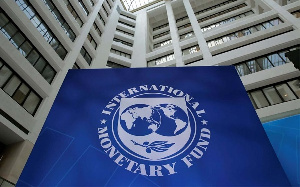 International Monetary Fund
International Monetary Fund
The International Monetary Fund (IMF) will on Monday August 23 2021, make resources equivalent to US$1 billion available to Ghana, in the form of a Special Drawing Rights (SDR) allocation.
Launched for all countries to respond to the worst peacetime global recession since the great depression, the SDR allocation follows the emergency financing disbursement, also of US$1 billion, under the Rapid Credit Facility approved by the Fund 18 months ago to help in the fight against the global pandemic.
To put these amounts in perspective, the Fund disbursed a grand total of US$925.9 million to Ghana over four years under the last Extended Credit Facility (2015-2019).
The allocation is a “shot in the arm” of the Ghanaian. It comes at a pivotal moment to help shore up the country’s foreign exchange reserves at the Bank of Ghana. The COVID-19 crisis has increased the foreign exchange Ghana needs to trade with the world (e.g., to pay for imports of vaccines or of machinery and equipment) while the capacity to earn foreign exchange through exports has not necessarily improved. Until now, Ghana has turned to international borrowing to meet these additional foreign exchange needs.
This SDR allocation provides an alternative to borrowing because Ghana does not need to reimburse the Fund. The allocation is not a loan as it represents Ghana’s share of the US$650 billion worth in SDR reserve assets created by the Fund and distributed to its members. The SDRs (SDR456 billion = US$650 billion), are distributed in proportion to countries’ shareholding in the IMF capital (or quota), which in turn closely relates to the size of their economies.
This is only the fourth general allocation since the creation of the IMF in 1944 and the largest by far. The most recent was in 2009, during the Global Financial Crisis when the IMF allocated the equivalent of US$250 billion in new SDRs to its membership. This time around the SDR allocation would provide liquidity support to many developing and low-income countries that are struggling, allowing them to pay for healthcare and support vulnerable people.
How SDRs are used is a sovereign decision and depends on each country’s specific needs and circumstances. Initially, SDRs are placed as a reserve asset on the books of the central bank. As such, they add to foreign exchange reserves, making the country more resilient financially because it can dip into higher reserves in case of emergency.
However, the SDRs can also be exchanged for hard currency and used to finance government spending. In this case, it is best practice to allocate it to priority areas consistent with a medium-term expenditure framework. Either as foreign exchange or as financing for government spending, the allocation will provide relief to Ghana.
Good governance and transparency are crucial in the use of these new resources. For example, enhanced budget procedures should be used to deal with COVID-19 related spending, including both internal and external audits.
But to be clear, the SDR allocation is no panacea. The allocation helps deal with the foreign exchange needs in the short term, but it does not address the root problem. In Ghana’s case, foreign exchange needs are mainly caused by large and persistent fiscal deficits and rising interest payments. Of course, Ghana’s success in saving lives and safeguarding livelihoods during the pandemic is also behind the larger deficits.
But, going forward, deficits and financing needs will need to decline to keep debt under control and reduce demand pressures on the economy. Therefore, improving domestic revenue mobilization remains crucial, so is reducing borrowing.
Progressive revenue measures—that spare the most vulnerable, and a faster return to the pre-pandemic level of spending should go a long way in shoring up public finances.